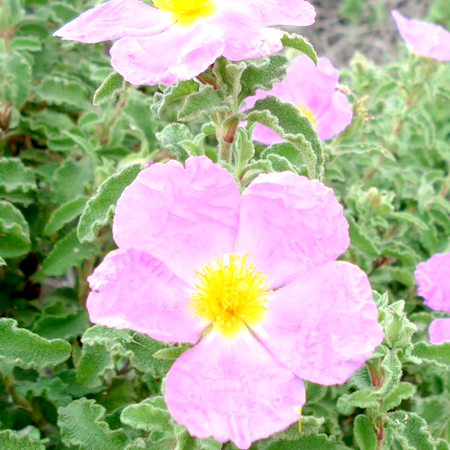

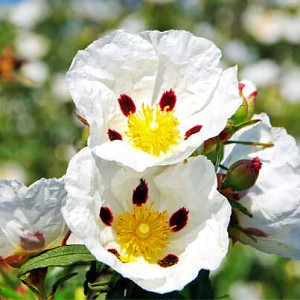
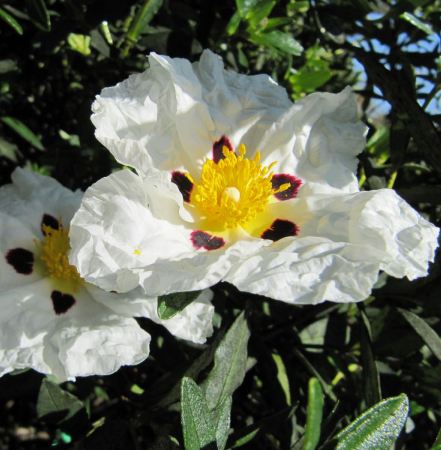
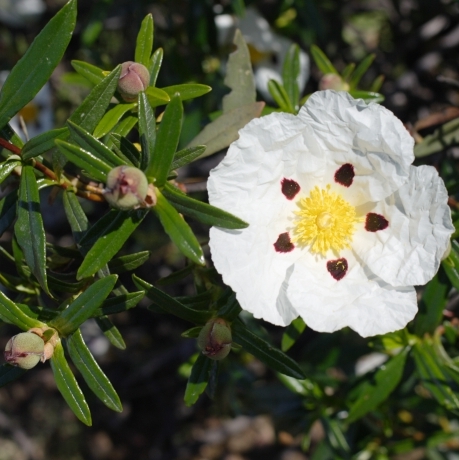
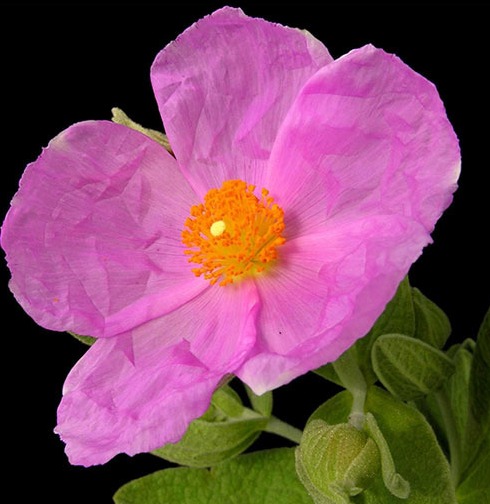
Botanical name Cistus Ladanifer
Family Cistaceae
Source Gum from leaves and terminal branches
Origin France
Processing Method Steam Distillation
Color/Consistency Yellow brown to brown clear liquid
Aromatic Summary / Note / Strength of Aroma Spicy-sweet, somewhat dry, musky, slightly leathery.
Blends With Frankincense, Sandalwood, Myrrh, Patchouli, Pine, Cypress, Clary Sage and Vetiver.
Product Abstract
Labdanum essential oil is often confused with cistus absolute oil because they are both derived from the same plant (cistus ladanifer). However cistus absolute is distilled in a different manner and from different parts of the plant and is considered of far less therapeutic value than real labdanum essential oil which is derived from the crude gum prepared by boiling the leaves and the twigs.
History
In ancient times, labdanum was collected by combing the beards and thighs of goats and sheep that had grazed on the cistus shrubs. Wooden instruments used were referred to in 19th-century Crete as ergastiri; a lambadistrion ("labdanum-gatherer") was a kind of rake to which a double row of leathern thongs were fixed instead of teeth. These were used to sweep the shrubs and collect the resin which was later extracted. It was collected by the shepherds and sold to coastal traders. The resin was used as an ingredient for incense, and medicinally to treat colds, coughs, menstrual problems and rheumatism.
Harvesting/Extraction Information
Labdanum essential oil which is used today in aromatherapy is derived from the leaves and twigs of the shrub by steam distillation. Its scent is sweet, woody with musky undertones and is highly valued in the perfume industry today for its ability to enhance multiple scents.
Common Usage
Caution
Dilute before use; for external use only. May cause skin irritation in some individuals; a skin test is recommended prior to use. Contact with eyes should be avoided.
Key constituents
a-Pinene 4.9–44.0%
3-Phenylproprionic acid 0–22.2%
Camphene 1.4–7.0%
a-Selinene 0–6.4%
p-Cymene 2.1–6.3%
Caryophyllene oxide 0–4.4%
Viridiflorol 1.4–3.7%
Heptyl vinyl ketone 0–2.9%
a-Terpineol 0–2.4%
Fenchone 1.4–2.3%
Bornyl acetate 1.2–2.1%
2,2,6-Trimethylcyclohexanone 1.7–2.0%
a-p-Dimethylstyrene 0–1.9%
Pinocarveol 0–1.8%
(Z)-Tagetenone 0–1.8%
Terpinen-4-ol 0–1.8%
Benzyl 3-phenylpropionate 0–1.7%
(E)-Cinnamic acid 0–1.4%
Borneol 1.1–1.3%
Pinocamphone 0–1.3%
Verbenone 0–1.2%
Ledol 0–1.1%
Germacrene D 0–1.0%
Safety summary
Hazards None known.
Contraindications None known
Organ-specific effects
Adverse skin reactions Undiluted labdanum oil was moderately irritating to rabbits; tested at 8% on 25 volunteers it was neither irritating nor sensitizing. It is non-phototoxic.
Systemic effects
Acute toxicity Non-toxic. Labdanum oil acute oral LD50 in rats 8.98 g/kg; acute dermal LD50 in rabbits >5 g/kg. 3-Phenylproprionic acid acute oral LD50 in mice 1.6 g/kg.
Carcinogenic/anticarcinogenic potential No information was found for labdanum oil, but it contains no known carcinogens.
Comments
The very low content of pinocamphone does not require any restriction for the GABAA receptor inhibitory neurotoxicity
normally associated with pinocamphone, especially since a-pinene potentiates GABAA receptor-mediated responses.
Labdanum oil is distilled from the gum, obtained by immersing the harvested plant material in boiling water. Also see cistus oil. Labdanum gum, and possibly absolute, contains labdane diterpenes such as labdane and sclareol.